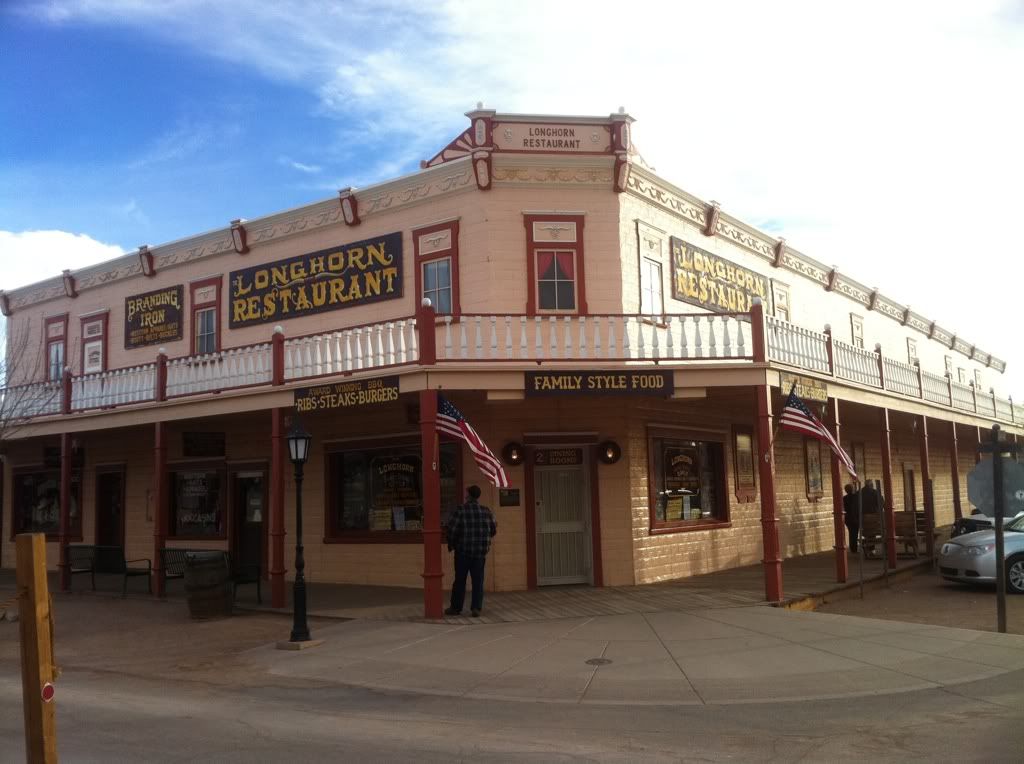We went to Tombstone yesterday, which is about 40 miles north of the Mexican border in Cochise County. There was a US Border Patrol checkpoint at a crossroads on Highway 80, about 5 miles north of Tombstone. It is a kiosk in the middle of the road, with pylons on each side of the highway narrowing the road down to the point where you stop before you pass by the kiosk. On the side of the road there is a parking lot on top of a coulee in the dirt, and it had about two dozen SUVs, pickups, and other vehicles parked there, all white with the green border patrol logo and lettering on them. Right beside where we stopped at the kiosk, there was an Hispanic guard standing by his SUV, fully armed, and I could catch a glimpse of the German Shepherd in the back seat. The vehicle had a plastic grill for a side window in the back seat for the dog, and it had a big convection fan mounted in it, so the dog could have some air. It’s only about 14 degrees here right now in the daytime, so I guess it saves on air conditioning.
The young flak-jacketed guard at the kiosk asked if we were Canadian citizens, then asked if we had our passports with us. Upon the affirmative answer, he asked if he could see them. I got them out, but as soon as he saw them in my hand, he said that was fine, and he was glad to see we were carrying them with us. He then waved us through. I found out later that this small checkpoint has 500 personnel stationed there.
I talked to some people from Chilliwack who pulled in beside us tonight, and they actually drove their big bus down past Tombstone today and into Agua Prieta, Mexico. They advised me not to go because all the stores are closed and the streets deserted because no one is going across due to the narcotraficante violence that is affecting the entire US-Mexico border areas. I feel for the average Mexican citizen, as this is hurting them financially and emotionally, and is going to have even worse impact as time goes on.
Tombstone itself is a city where people live and work, so there are modern-day vehicles parked and driving all around Tombstone, except for a few blocks in the main historic part. All the buildings have been rebuilt and restored, most with inappropriate alterations and not to original specifications of the period. The old town actually burnt down at least twice in the late 1800s, so it’s understandable but a little disappointing as it felt a little Hollywood.
Above: Huge original painting of Fatima, one of the dancers who performed here at the Bird Cage. There are at least two bullet holes and a knife slash in it, courtesy of patrons of that era.
There are only a couple of original buildings left there, one of which is the Bird Cage Theatre. You can go into the front area, and then pay to see the rest, which we did. We thought it was the best of the buildings in Tombstone, with many original artifacts there, including the original horse-drawn hearse that took the famous OK Corral victims to Boot Hill. The building is in its original state and has held up very well over the years.
We also paid to watch a reenactment of the shootout at the OK Corral, which was in the form of an outdoor play and gave a background of the events leading up to the shootings, culminating in the actual shooting. Some of the actors bore striking resemblances to the actual people, as we later saw from old photos in the Bird Cage.
Above: Bullet holes, large calibre, in the stage at the Bird Cage
There are also signs at the doorways of most buildings requiring that firearms be checked at the front before going in. This may sound like part of the historic feature of Tombstone, but is actually for real-day patrons as it is legal to carry firearms in this state. Apparently there are no permits required to buy anything other than a handgun, and there are no registrations required for anything except concealed weapons. Carrying a firearm in a holster that is partly visible is not considered concealed, nor is it concealed to have them in luggage, vehicle, or house.
Above: Some of the private boxes to the left of the stage at The Bird Cage Theatre
This state was pretty wild in the late 1800s, to the point where the federal government considered sending in the army and enacting martial law to settle it down. In1882, the New York Times reported that "the Bird Cage Theatre is the wildest, wickedest night spot between Basin Street and the Barbary Coast." Tombstone then had a law that people entering town had to turn in their firearms and pick them up when they left, which was part of the reason for the confrontation at the OK Corral.









No comments:
Post a Comment